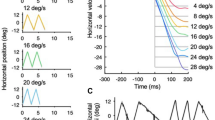Abstract
Maintenance of movement accuracy relies on motor learning, by which prior errors guide future behavior. One aspect of this learning process involves the accurate generation of predictions of movement outcome. These predictions can, for example, drive anticipatory movements during a predictive-saccade task. Predictive saccades are rapid eye movements made to anticipated future targets based on error information from prior movements. This predictive process exhibits long-memory (fractal) behavior, as suggested by inter-trial fluctuations. Here, we model this learning process using a regime-switching approach, which avoids the computational complexities associated with true long-memory processes. The resulting model demonstrates two fundamental characteristics. First, long-memory behavior can be mimicked by a system possessing no true long-term memory, producing model outputs consistent with human-subjects performance. In contrast, the popular two-state model, which is frequently used in motor learning, cannot replicate these findings. Second, our model suggests that apparent long-term memory arises from the trade-off between correcting for the most recent movement error and maintaining consistent long-term behavior. Thus, the model surprisingly predicts that stronger long-memory behavior correlates to faster learning during adaptation (in which systematic errors drive large behavioral changes); greater apparent long-term memory indicates more effective incorporation of error from the cumulative history across trials.






Similar content being viewed by others
References
Bassingthwaighte, J. B., L. S. Liebovitch, and B. J. West. Fractal Physiology. New York: Published for the American Physiological Society by Oxford University Press, 1994.
Cheng, S., and P. N. Sabes. Modeling sensorimotor learning with linear dynamical systems. Neural Comput. 18:760–793, 2006.
Collins, J. J., and C. J. De Luca. Random walking during quiet standing. Phys. Rev. Lett. 73:764–767, 1994.
Collins, T., and J. Wallman. The relative importance of retinal error and prediction in saccadic adaptation. J. Neurophysiol. 107:3342–3348, 2012.
Criscimagna-Hemminger, S. E., A. J. Bastian, and R. Shadmehr. Size of error affects cerebellar contributions to motor learning. J. Neurophysiol. 103:2275–2284, 2010.
Davidson, P. R., and D. M. Wolpert. Scaling down motor memories: de-adaptation after motor learning. Neurosci. Lett. 370:102–107, 2004.
Diebold, F. X., and A. Inoue. Long memory and regime switching. J. Econom. 105:131–159, 2001.
Floyer-Lea, A., and P. M. Matthews. Changing brain networks for visuomotor control with increased movement automaticity. J. Neurophysiol. 92:2405–2412, 2004.
Granger, C. W. J. Long memory relationships and the aggregation of dynamic models. J. Econom. 14:227–238, 1980.
Hausdorff, J. M., C. K. Peng, Z. Ladin, J. Y. Wei, and A. L. Goldberger. Is walking a random walk? Evidence for long-range correlations in stride interval of human gait. J. Appl. Physiol. 78:349–358, 1995.
Hurst, H. E. Long-term storage capacity of reservoirs. Trans. Am. Soc. Civ. Eng. 116:770–808, 1951.
Hurst, H. E., R. P. Black, and Y. M. Samayka. Long-Term Storage: An Experimental Case Study. London: Constable, 1965.
Joiner, W. M., and M. Shelhamer. Responses to noisy periodic stimuli reveal properties of a neural predictor. J. Neurophysiol. 96:2121–2126, 2006.
Kording, K., J. B. Tenenbaum, and R. Shadmehr. Multiple timescales and uncertainty in motor adaptation. In: Advances in Neural Information Processing Systems, Vol. 19, edited by B. Scholkopf, J. Platt, and T. Hoffman. Cambridge, MA: MIT Press, 2007, pp. 745–752.
Leigh, R. J., and D. S. Zee. The Neurology of Eye Movements. New York: Oxford University Press, 2006.
Miller, J. M., T. Anstis, and W. B. Templeton. Saccadic plasticity: parametric adaptive control by retinal feedback. J. Exp. Psychol. Hum. Percept. Perform. 7:356–366, 1981.
Rangarajan, G., and M. Ding. Integrated approach to the assessment of long range correlation in time series data. Phys. Rev. E 61:4991–5001, 2000.
Riley, M. A., and M. T. Turvey. Variability of determinism in motor behavior. J. Mot. Behav. 34:99–125, 2002.
Shelhamer, M., and W. M. Joiner. Saccades exhibit abrupt transition between reactive and predictive; predictive saccade sequences have long-term correlations. J. Neurophysiol. 90:2763–2769, 2003.
Slifkin, A. B., and K. M. Newell. Noise, information transmission, and force variability. J. Exp. Psychol. Hum. Percept. Perform. 25:837–851, 1999.
Smith, M. A., A. Ghazizadeh, and R. Shadmehr. Interacting adaptive processes with different timescales underlie short-term motor learning. PLoS Biol. 4:e179, 2006.
Srimal, R., J. Diedrichsen, E. B. Ryklin, and C. E. Curtis. Obligatory adaptation of saccade gains. J. Neurophysiol. 99:1554–1558, 2008.
Stergiou, N., and L. M. Decker. Human movement variability, nonlinear dynamics, and pathology: is there a connection? Hum. Mov. Sci. 30(5):869–888, 2011.
Wagenmakers, E. J., S. Farrell, and R. Ratcliff. Estimation and interpretation of 1/falpha noise in human cognition. Psychon. Bull. Rev. 11:579–615, 2004.
Wang, G. D., G. Antar, and P. Devynck. The Hurst exponent and long-time correlation. Phys. Plasmas 7:1181–1183, 2000.
Wong, A. L., and M. Shelhamer. Exploring the fundamental dynamics of error-based motor learning using a stationary predictive-saccade task. PLoS ONE 6:e25225, 2011.
Wong, A. L., and M. Shelhamer. Saccade adaptation improves in response to a gradually introduced stimulus perturbation. Neurosci. Lett. 500:207–211, 2011.
Wong, A. L., and M. Shelhamer. Sensorimotor adaptation error signals are derived from realistic predictions of movement outcomes. J. Neurophysiol. 105:1130–1140, 2011.
Zarahn, E., G. D. Weston, J. Liang, P. Mazzoni, and J. W. Krakauer. Explaining savings for visuomotor adaptation: linear time-invariant state-space models are not sufficient. J. Neurophysiol. 100:2537–2548, 2008.
Acknowledgments
This work was supported by NSF Grant BCS-0615106, NIH Grant R21-EY019713, and NIH Grant T32 DC000023.
Author information
Authors and Affiliations
Corresponding author
Additional information
Associate Editor Thurmon E. Lockhart oversaw the review of this article.
Electronic supplementary material
Below is the link to the electronic supplementary material.
Rights and permissions
About this article
Cite this article
Wong, A.L., Shelhamer, M. A Long-Memory Model of Motor Learning in the Saccadic System: A Regime-Switching Approach. Ann Biomed Eng 41, 1613–1624 (2013). https://doi.org/10.1007/s10439-012-0669-2
Received:
Accepted:
Published:
Issue Date:
DOI: https://doi.org/10.1007/s10439-012-0669-2




